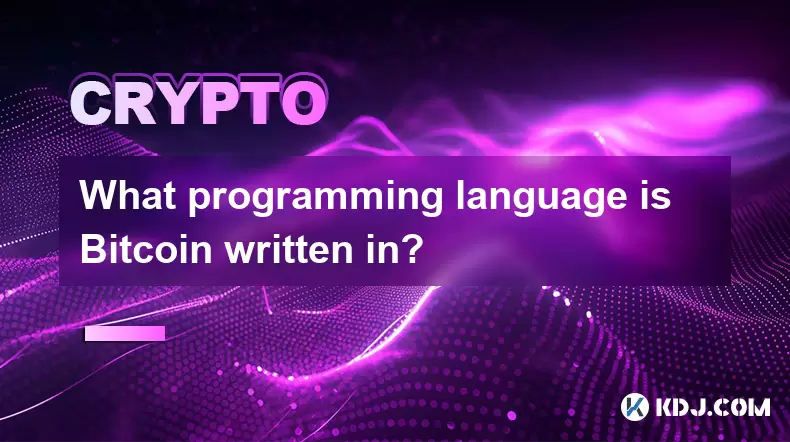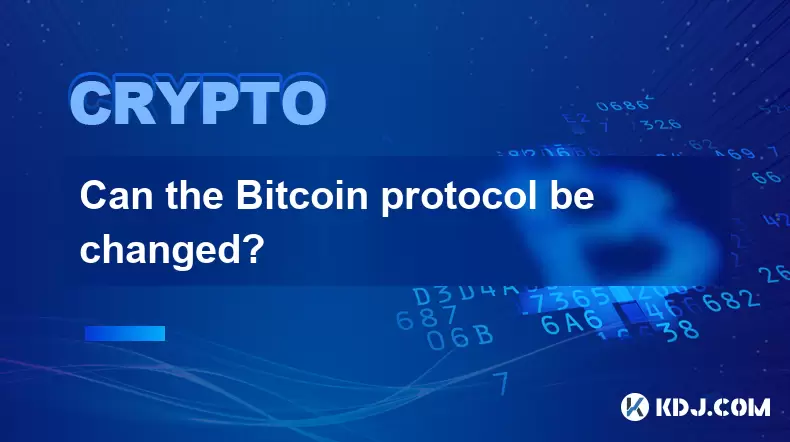-
 bitcoin
bitcoin $114779.865156 USD
2.30% -
 ethereum
ethereum $4226.519789 USD
2.39% -
 tether
tether $1.000545 USD
0.04% -
 xrp
xrp $2.890223 USD
0.92% -
 bnb
bnb $1030.029301 USD
2.95% -
 solana
solana $212.824944 USD
1.69% -
 usd-coin
usd-coin $0.999757 USD
0.01% -
 dogecoin
dogecoin $0.234961 USD
-0.27% -
 tron
tron $0.337174 USD
0.42% -
 cardano
cardano $0.804783 USD
0.09% -
 hyperliquid
hyperliquid $45.748770 USD
-2.85% -
 chainlink
chainlink $21.699170 USD
0.82% -
 ethena-usde
ethena-usde $1.001452 USD
0.08% -
 avalanche
avalanche $30.237800 USD
1.14% -
 stellar
stellar $0.372604 USD
1.52%
What programming language is Bitcoin written in?
Bitcoin's core is built in C++ for high performance, security, and system-level control, essential for blockchain operations like transaction validation and peer-to-peer networking.
Jul 07, 2025 at 07:15 am

Understanding Bitcoin's Core Programming Language
Bitcoin, the pioneering decentralized digital currency, was originally developed using C++. This choice of programming language is critical for understanding how Bitcoin operates at its most fundamental level. C++ provides high performance, low-level memory manipulation, and strong control over system resources — all essential features for a distributed ledger system like Bitcoin.
The core implementation of Bitcoin, known as Bitcoin Core, serves as the reference implementation and is written entirely in C++. It powers full nodes that validate transactions and blocks across the network. The source code is publicly available on GitHub, allowing developers to review, contribute, or fork the project.
Why Was C++ Chosen for Bitcoin?
The decision to use C++ for Bitcoin was not arbitrary. Satoshi Nakamoto, the pseudonymous creator(s) of Bitcoin, needed a language that could efficiently manage resource-intensive operations such as cryptographic hashing, transaction validation, and peer-to-peer networking.
C++ offers several advantages:
- High performance: Essential for handling large volumes of data and maintaining synchronization across the network.
- Object-oriented design: Facilitates modular development and reusable components.
- Cross-platform compatibility: Bitcoin can be compiled and run on various operating systems including Linux, macOS, and Windows.
- Direct hardware access: Necessary for optimizing network communication and disk I/O operations.
These characteristics make C++ an ideal fit for a blockchain protocol that must function reliably and securely under heavy load.
Exploring Bitcoin Core's Code Structure
The Bitcoin Core repository contains thousands of lines of C++ code organized into multiple directories. Key components include:
- src/: Contains the main source files, including
main.cpp,wallet.cpp, andnet.cpp. - include/: Houses header files used across the project.
- contrib/: Includes tools and scripts contributed by the community.
- qa/: Holds test suites and automation tools for quality assurance.
Each file plays a specific role in maintaining the functionality and security of the Bitcoin network. For example, miner.cpp handles block creation, while rpcserver.cpp manages remote procedure calls for interacting with the node.
How to Compile Bitcoin Core from Source
Compiling Bitcoin Core from source allows users to verify the integrity of the software and customize it for specific needs. Below are detailed steps for compiling Bitcoin Core on a Unix-based system:
Install necessary dependencies:
- Build essentials:
sudo apt-get install build-essential - Libtool:
sudo apt-get install libtool - Autotools:
sudo apt-get install autoconf automake - Boost libraries:
sudo apt-get install libboost-all-dev - Berkeley DB:
sudo apt-get install libdb-dev libdb++-dev - ZMQ:
sudo apt-get install libzmq3-dev
- Build essentials:
Clone the Bitcoin Core repository:
- Run
git clone https://github.com/bitcoin/bitcoin.git
- Run
Navigate to the source directory:
- Use
cd bitcoin
- Use
Configure the build:
- Execute
./autogen.sh && ./configure --disable-wallet --without-gui
- Execute
Build the binaries:
- Run
make
- Run
Verify the build:
- Use
make checkto ensure everything compiles correctly
- Use
This process results in executable files such as bitcoind (the daemon), bitcoin-cli (command-line interface), and bitcoin-qt (GUI wallet if enabled).
Other Languages Used in the Bitcoin Ecosystem
While Bitcoin Core is primarily written in C++, many other languages are used throughout the broader ecosystem. These include:
- Python: Often used for scripting and testing Bitcoin applications.
- JavaScript: Powers web-based wallets and explorers.
- Go (Golang): Utilized in some alternative implementations and sidechains.
- Rust: Gaining popularity for building secure and efficient Bitcoin-related tools.
However, these languages are typically used for higher-level applications or tools rather than the core consensus layer. The consensus-critical parts of Bitcoin remain firmly rooted in C++.
Contributing to Bitcoin Core Development
Contributing to Bitcoin Core development requires a solid understanding of C++ and blockchain principles. Developers interested in participating should follow these steps:
- Fork the official repository from GitHub
- Set up a local development environment with required libraries
- Make changes following the project’s coding standards
- Submit a pull request with clear documentation
- Engage with the community for code review and feedback
All contributions undergo rigorous testing and peer review before being merged into the main branch. Participation helps maintain Bitcoin’s security and decentralization.
Frequently Asked Questions
Q1: Can Bitcoin be rewritten in another programming language?Yes, theoretically, Bitcoin can be rewritten in another language, but doing so would require replicating all consensus rules accurately. Several alternative implementations exist in other languages, such as btcd (Go) and bcoin (JavaScript), though they are not considered reference implementations.
Q2: Is Python used in Bitcoin's core development?No, Python is not used in Bitcoin Core's consensus layer. However, it is commonly used for writing tests, scripts, and tools that interact with Bitcoin nodes via RPC or REST APIs.
Q3: Are there any security risks associated with using C++ for Bitcoin?Like any language, C++ has potential vulnerabilities, especially around memory management. However, Bitcoin Core developers implement strict coding practices and extensive testing to mitigate risks. Security audits and formal verification tools are also used to enhance safety.
Q4: What tools are commonly used to analyze Bitcoin's source code?Popular tools for analyzing Bitcoin Core’s C++ codebase include Clang, Valgrind, GDB, and static analysis tools like Coverity and Cppcheck. Additionally, IDEs like CLion and Visual Studio Code with C++ extensions are widely adopted.
Disclaimer:info@kdj.com
The information provided is not trading advice. kdj.com does not assume any responsibility for any investments made based on the information provided in this article. Cryptocurrencies are highly volatile and it is highly recommended that you invest with caution after thorough research!
If you believe that the content used on this website infringes your copyright, please contact us immediately (info@kdj.com) and we will delete it promptly.
- BlockDAG, DOGE, HYPE Sponsorship: Crypto Trends Shaping 2025
- 2025-10-01 00:25:13
- Deutsche Börse and Circle: A StableCoin Adoption Powerhouse in Europe
- 2025-10-01 00:25:13
- BlockDAG's Presale Buzz: Is It the Crypto to Watch in October 2025?
- 2025-10-01 00:30:13
- Bitcoin, Crypto, and IQ: When Genius Meets Digital Gold?
- 2025-10-01 00:30:13
- Stablecoins, American Innovation, and Wallet Tokens: The Next Frontier
- 2025-10-01 00:35:12
- NBU, Coins, and Crypto in Ukraine: A New Yorker's Take
- 2025-10-01 00:45:14
Related knowledge

Why is Bitcoin considered a revolutionary technology?
Aug 12,2025 at 08:29pm
Decentralization and the Elimination of Central AuthoritiesThe core innovation behind Bitcoin lies in its decentralized architecture, which fundamenta...

Why is Bitcoin considered a revolutionary technology?
Aug 10,2025 at 07:42pm
Decentralized Architecture and Trustless TransactionsBitcoin is considered revolutionary because it introduced a decentralized architecture that opera...

What are the key features of Bitcoin?
Aug 10,2025 at 02:50am
Decentralization and Peer-to-Peer NetworkOne of the most defining characteristics of Bitcoin is its decentralized nature. Unlike traditional financial...

Can the Bitcoin protocol be changed?
Aug 07,2025 at 01:16pm
Understanding the Bitcoin ProtocolThe Bitcoin protocol is the foundational set of rules that govern how the Bitcoin network operates. It defines every...

Can the Bitcoin protocol be changed?
Aug 11,2025 at 01:01am
Understanding the Bitcoin Protocol StructureThe Bitcoin protocol is the foundational set of rules that govern how the Bitcoin network operates. These ...

What happens to Bitcoin transactions once they are confirmed?
Aug 09,2025 at 05:22am
Understanding Bitcoin Transaction ConfirmationWhen a Bitcoin transaction is initiated, it is broadcast to the network and placed in a pool of unconfir...

Why is Bitcoin considered a revolutionary technology?
Aug 12,2025 at 08:29pm
Decentralization and the Elimination of Central AuthoritiesThe core innovation behind Bitcoin lies in its decentralized architecture, which fundamenta...

Why is Bitcoin considered a revolutionary technology?
Aug 10,2025 at 07:42pm
Decentralized Architecture and Trustless TransactionsBitcoin is considered revolutionary because it introduced a decentralized architecture that opera...

What are the key features of Bitcoin?
Aug 10,2025 at 02:50am
Decentralization and Peer-to-Peer NetworkOne of the most defining characteristics of Bitcoin is its decentralized nature. Unlike traditional financial...

Can the Bitcoin protocol be changed?
Aug 07,2025 at 01:16pm
Understanding the Bitcoin ProtocolThe Bitcoin protocol is the foundational set of rules that govern how the Bitcoin network operates. It defines every...

Can the Bitcoin protocol be changed?
Aug 11,2025 at 01:01am
Understanding the Bitcoin Protocol StructureThe Bitcoin protocol is the foundational set of rules that govern how the Bitcoin network operates. These ...

What happens to Bitcoin transactions once they are confirmed?
Aug 09,2025 at 05:22am
Understanding Bitcoin Transaction ConfirmationWhen a Bitcoin transaction is initiated, it is broadcast to the network and placed in a pool of unconfir...
See all articles










































































